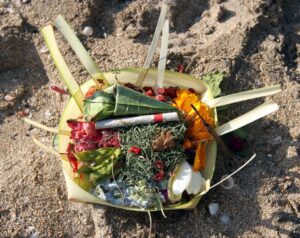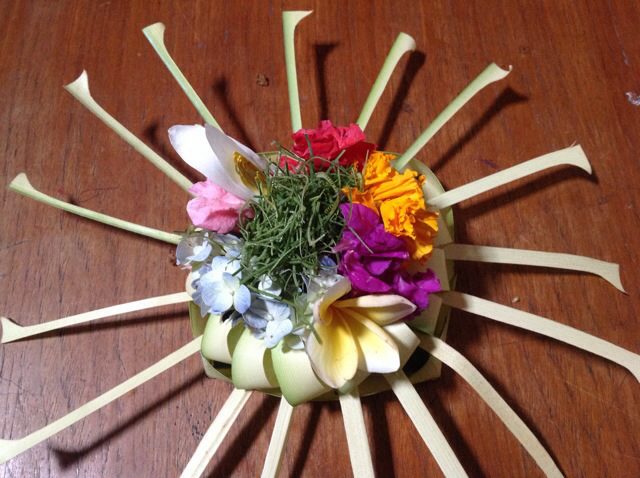Bali can be a delight – and even overwhelming to visitors. There are the main tourist areas, the beaches, even some familiar brand name stores and restaurants. But even among these are found some signs of the Balinese traditions and heritage. The most easily recognized, are the small daily offerings made. Incense can be wafting the smells, the small trials of smoke….of perhaps it is the little baskets with bright flowers. It is one of the first you notice walking on any street. These little packages are everywhere. And they come in many forms, and are found in so many places that visitors soon realize they are an important part of everyday life on Bali.
These are called Canang Sari. These are offerings and are a part of the intricate religious life of Balinese. While it may seem a small thing – they contain a great deal of significance, from the colors chosen, the materials used, the way they are laid out…and where they are placed.

Canang sari offerings are part of daily life in Bali, representing the devotion of Balinese Hindus to the gods and maintaining balance with the divine. These are typically small woven palm leaf baskets filled with flowers, incense, and other items (even cigarettes, candy and coins). That are found carefully placed along the sides of the road, in front of homes and shops, at the entrance to temples, and essentially everywhere on the island. There are large elaborate ones for ceremonies and events. To a visitor, these offerings might seem like a charming (and photogenic) detail, but they are much more than that.
The creation and offering of canang sari is traditionally the domain of women in Bali. If you take the time to walk and explore Bali in the mornings (and we do recommend it), you will witness households across the island, Balinese women wake early to craft these offerings, taking great care to prepare them according to long-held traditions. The palm leaf base represents the earth, while flowers are added in specific directions and colors to symbolize various gods of the Hindu pantheon. Other items like lime, betel nut, cookies, or even cigarettes may be included to honor certain deities or represent selflessness. The gods are understood to enjoy life as we do – so honoring them with small sacrifices is normal. While the intricacies of canang sari may seem confusing to visitors and even long time residents, for Balinese women, the ritual of preparing them is ingrained from a young age. Mothers pass down knowledge to daughters on the precise ingredients, directions, prayers, and rituals involved in making the perfect offering. Preparing canang sari is an act of selflessness, taking time and effort away from other chores to craft these gifts for the gods. In the past, women would gather materials from nature and weave the palm leaf bases by hand, making the process more meditative. Now, as more women work outside the home, they often purchase pre-made bases and materials from the market to save time, but still take care in assembling them. You will often see piles of these small baskets, small mountains of flowers and other ingredients in the markets.

Every traditional Balinese house has a Sanggah, or small temple. Once created, the canang sari are placed reverently around the home, sanggah, shop, temple, or other locations, accompanied by quiet prayers for blessings from the gods. Holy water is sprinkled over the offering, incense lit, and the smoke carries its essence upwards. In almost every street, shop and office – you can witness this. These offerings are not meant to be permanent fixtures. This is not a “do it once and forget”, these are part of daily routines. And it is expected that they disintegrate back into nature after serving their spiritual purpose. Animals may take parts of the canang sari to eat, further giving back to the natural world. Wind and rain may knock them over. And even people walking by may step on or kick them.
For Balinese Hindus, making and giving these daily offerings represents their devotion to the gods and an expression of gratitude for blessings received. The creation process connects them to their ancestry, passing down traditions from mother to daughter. Placing the canang sari around Bali reminds and reinforces their commitment to maintaining balance and harmony with the divine at all times and places. These are everywhere, from the beach to the forests to the mountaintops, showing how religion permeates every aspect of life on the island.
To visitors in Bali, the canang sari may appear to be merely colorful opportunities for photography against the backdrop. But understanding the spiritual meaning and symbolism transforms them from instagram posts to representations of the Balinese worldview – one that centers on devotion, gratitude, and duty to the gods that permeates daily life. And they are everywhere!
In addition to their spiritual significance, canang sari offerings are often placed at intersections and landmarks in Bali. These locations are chosen for their spiritual significance and practical benefits. Intersections are seen as meeting points between realms, where the realm of humans, gods, and demons intersect. Even if those are really busy intersections on main roads! Canang sari offerings are placed at intersections to placate demons and honor gods at these liminal spaces. Bridges connect different realms, between land and sea, mountains, or over rivers. Canang sari offerings are left on bridges to protect those crossing into different worlds. Large old trees are thought to be inhabited by spirits. Canang sari offerings are left at these trees to show respect and ask permission from these nature spirits. Other landmarks like mountains, oceans, springs, etc. have spiritual protectors that are honored with canang sari offerings.
In addition to their spiritual significance, canang sari offerings at landmarks and intersections have practical benefits. They remind people of their Hindu faith and philosophy when moving through their daily life. They visibly sanctify public spaces, keeping unwanted spirits out. They ask for safety and protection at dangerous areas like intersections. They also provide food for animals and insects when offerings disintegrate.
Overall, canang sari offerings are an integral part of Balinese Hinduism and are placed at significant landmarks and intersections to honor the gods and maintain balance and harmony between realms. They are also practical in their ability to sanctify public spaces and provide food for animals. To visitors in Bali, understanding the significance of canang sari offerings can provide a deeper appreciation for the Balinese culture and worldview.




